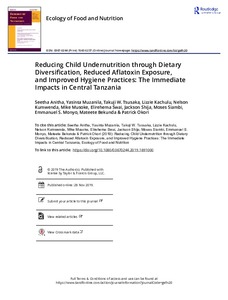| dc.contributor.author | Anitha, S. |
| dc.contributor.author | Muzanila, Y. |
| dc.contributor.author | Tsusaka, T.W. |
| dc.contributor.author | Kachulu, L. |
| dc.contributor.author | Kumwenda, N. |
| dc.contributor.author | Musoke, M. |
| dc.contributor.author | Swai, E. |
| dc.contributor.author | Shija, J. |
| dc.contributor.author | Siambi, M. |
| dc.contributor.author | Monyo, E.S. |
| dc.contributor.author | Bekunda, N.A. |
| dc.contributor.author | Okori, P. |
| dc.date.accessioned | 2020-08-05T13:27:41Z |
| dc.date.available | 2020-08-05T13:27:41Z |
| dc.date.issued | 2019 |
| dc.identifier.citation | Anitha, S., Muzanila, Y., Tsusaka, T.W., Kachulu, L., Kumwenda, N., Musoke, M., ... & Okori, P. (2019). Reducing child undernutrition through dietary diversification, reduced aflatoxin exposure, and improved hygiene practices: the immediate impacts in central Tanzania. Ecology of Food and Nutrition, 59(3), 243-262. |
| dc.identifier.issn | 0367-0244 |
| dc.identifier.uri | https://hdl.handle.net/20.500.12478/6911 |
| dc.description.abstract | The study aimed to quantify the immediate effects of dietary diversification, food safety, and hygiene interventions on child undernutrition in four rural villages in Kongwa district of central Tanzania. One hundred mothers with their children of less than 24 months old were recruited for this study. The difference-in-difference (DID) method was used to assess the effects of intensive intervention through a learning-by-doing process on the topic of aflatoxin free diversified food utilization and improved hygiene practices. Periodic anthropometric measurements were conducted on the 0th, 7th, 14th, and 21st days, and DID estimator showed the significant and positive average marginal effects of the intervention on Z-Scores being 0.459, 0.252, and 0.493 for wasting, stunting, and underweight, respectively. Notably, at the end of the study, the mean aflatoxin M1 level in urine samples decreased by 64% in the intervention group, while it decreased by 11% in the control group. The study provides quantitative evidence on intensive 21-day training for mothers incorporating integrated technologies yielded positive impacts on their children’s nutritional outcomes. |
| dc.description.sponsorship | United States Agency for International Development |
| dc.format.extent | 243-262 |
| dc.language.iso | en |
| dc.subject | Malnutrition |
| dc.subject | Foods |
| dc.subject | Aflatoxins |
| dc.subject | Food Safety |
| dc.subject | Food Security |
| dc.subject | Nutritional Disorders |
| dc.subject | Kwashiorkor |
| dc.title | Reducing child undernutrition through dietary diversification, reduced aflatoxin exposure, and improved hygiene practices: the immediate impacts in central Tanzania |
| dc.type | Journal Article |
| cg.contributor.crp | Maize |
| cg.contributor.affiliation | International Crops Research Institute for the Semi-Arid Tropics |
| cg.contributor.affiliation | Sokoine University of Agriculture |
| cg.contributor.affiliation | Agricultural Research Institute, Tanzania |
| cg.contributor.affiliation | District Agriculture and Irrigation department, Kongwa District Council, Tanzania |
| cg.contributor.affiliation | International Institute of Tropical Agriculture |
| cg.coverage.region | Africa |
| cg.coverage.region | East Africa |
| cg.coverage.country | Tanzania |
| cg.coverage.hub | Eastern Africa Hub |
| cg.researchtheme | Natural Resource Management |
| cg.identifier.bibtexciteid | ANITHA:2019 |
| cg.isijournal | ISI Journal |
| cg.authorship.types | CGIAR and developing country institute |
| cg.iitasubject | Aflatoxin |
| cg.iitasubject | Biofortification |
| cg.iitasubject | Food Science |
| cg.iitasubject | Food Security |
| cg.iitasubject | Natural Resource Management |
| cg.iitasubject | Nutrition |
| cg.journal | Ecology of Food and Nutrition |
| cg.notes | Open Access Article; Published online: 28 Nov 2019 |
| cg.accessibilitystatus | Open Access |
| cg.reviewstatus | Peer Review |
| cg.usagerightslicense | Creative Commons Attribution 4.0 (CC BY 0.0) |
| cg.targetaudience | Scientists |
| cg.identifier.doi | https://dx.doi.org/10.1080/03670244.2019.1691000 |
| cg.iitaauthor.identifier | Mateete Bekunda: 0000-0001-7297-9383 |

